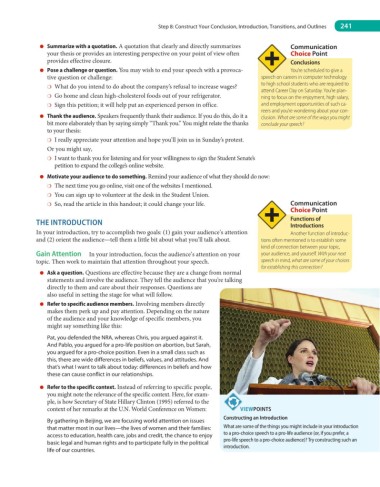Page 262 - Essentials of Human Communication
P. 262
Step 8: Construct Your Conclusion, Introduction, Transitions, and Outlines 241
● Summarize with a quotation. A quotation that clearly and directly summarizes Communication
your thesis or provides an interesting perspective on your point of view often Choice point
provides effective closure. Conclusions
● Pose a challenge or question. You may wish to end your speech with a provoca- You’re scheduled to give a
tive question or challenge: speech on careers in computer technology
❍ What do you intend to do about the company’s refusal to increase wages? to high school students who are required to
attend Career Day on Saturday. You’re plan-
❍ Go home and clean high-cholesterol foods out of your refrigerator. ning to focus on the enjoyment, high salary,
❍ Sign this petition; it will help put an experienced person in office. and employment opportunities of such ca-
reers and you’re wondering about your con-
● Thank the audience. Speakers frequently thank their audience. If you do this, do it a clusion. What are some of the ways you might
bit more elaborately than by saying simply “Thank you.” You might relate the thanks conclude your speech?
to your thesis:
❍ I really appreciate your attention and hope you’ll join us in Sunday’s protest.
Or you might say,
❍ I want to thank you for listening and for your willingness to sign the Student Senate’s
petition to expand the college’s online website.
● Motivate your audience to do something. Remind your audience of what they should do now:
❍ The next time you go online, visit one of the websites I mentioned.
❍ You can sign up to volunteer at the desk in the Student Union.
❍ So, read the article in this handout; it could change your life. Communication
Choice point
Functions of
the intrOduCtiOn introductions
In your introduction, try to accomplish two goals: (1) gain your audience’s attention Another function of introduc-
and (2) orient the audience—tell them a little bit about what you’ll talk about. tions often mentioned is to establish some
kind of connection between your topic,
Gain attention In your introduction, focus the audience’s attention on your your audience, and yourself. With your next
topic. Then work to maintain that attention throughout your speech. speech in mind, what are some of your choices
for establishing this connection?
● Ask a question. Questions are effective because they are a change from normal
statements and involve the audience. They tell the audience that you’re talking
directly to them and care about their responses. Questions are
also useful in setting the stage for what will follow.
● Refer to specific audience members. Involving members directly
makes them perk up and pay attention. Depending on the nature
of the audience and your knowledge of specific members, you
might say something like this:
Pat, you defended the NRA, whereas Chris, you argued against it.
And Pablo, you argued for a pro-life position on abortion, but Sarah,
you argued for a pro-choice position. Even in a small class such as
this, there are wide differences in beliefs, values, and attitudes. And
that’s what I want to talk about today: differences in beliefs and how
these can cause conflict in our relationships.
● Refer to the specific context. Instead of referring to specific people,
you might note the relevance of the specific context. Here, for exam-
ple, is how Secretary of State Hillary Clinton (1995) referred to the
context of her remarks at the U.N. World Conference on Women: ViewpOints
Constructing an introduction
By gathering in Beijing, we are focusing world attention on issues
that matter most in our lives—the lives of women and their families: What are some of the things you might include in your introduction
access to education, health care, jobs and credit, the chance to enjoy to a pro-choice speech to a pro-life audience (or, if you prefer, a
basic legal and human rights and to participate fully in the political pro-life speech to a pro-choice audience)? Try constructing such an
introduction.
life of our countries.

